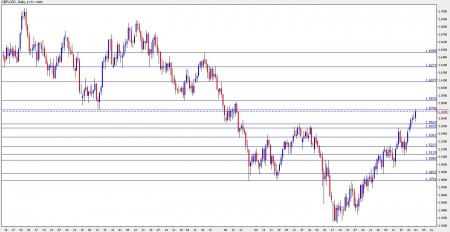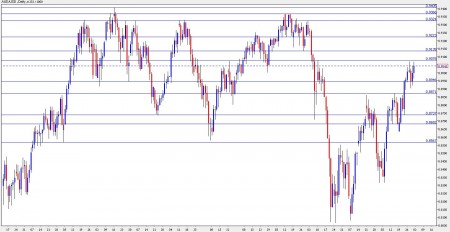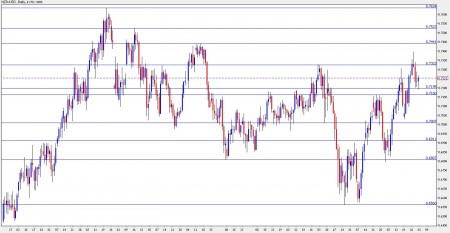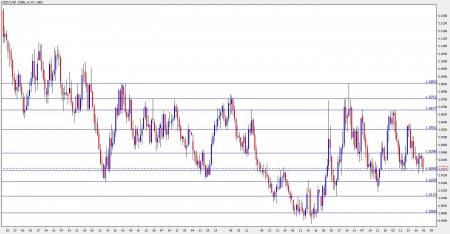| GBP/USD Outlook – August 2-6 Posted: 31 Jul 2010 05:20 PM PDT 

A very busy week expects cable traders, with 9 important events. The rate decision is the peak but other data will also rock the rising Pound. Here’s an outlook for the British events and an updated technical analysis for GBP/USD. GBP/USD daily chart with support and resistance lines on it. Click to enlarge: 
In the past week, Mervyn King finally ackowledged the rising inflation and sent the Pound over the tough 1.5520 resistance line, for the first time in 5 months. Will this continue? Let’s start:
- Halifax HPI: Publication time unknown at the moment. After the Nationwide HPI disappointed with a drop of 0.5% in prices of homes, also this indicator is expected to show a drop of 0.4% – the third consecutive drop. The figure is based on the internal data of HBOS, making it very reliable. The Pound will rock with every result.
- Manufacturing PMI: Published on Monday at 8:30 GMT. According to this survey of 600 purchasing mangers in the manufacturing sector, Britain continues to grow at a stable and good pace, with the score standing at 57.5 points, high above the critical 50 point bar, meaning economic expansion. It’s expected to slightly drop to 57.1
- Construction PMI: Published on Tuesday at 8:30 GMT. Contrary to the manufacturing and services sectors, purchasing managers in the construction sector turned positive only 4 months ago, but this indicator also reached a high score of 58.4. Also here, it’s expected to edge down to 58.2 points.
- Nationwide Consumer Confidence: The Nationwide Building Society surveys 1000 consumers for this important indicator. Despite the recovery in employment, consumer confidence deteriorated in the past few months. After gradually dropping from 81 to 63 points, another slide is predicted – to 60. This indicator is highly regarded by the MPC, just before the rate decision.
- Services PMI: Published on Wednesday at 8:30 GMT. Completing the array of PMIs, the services sector isn’t doing as well as the other sectors. From a score of 54.4 (still positive), Services PMI is likely to rise to 54.8 points. This is the last indicator before the rate decision.
- Rate decision: Published on Thursday at 11:00 GMT. Official expectations for the Official Bank Rate are for an unchanged value of 0.50%. But, things are starting to move in Britain. Apart from Andrew Sentance, that already voted for a rate hike, the improving employment and fast growth in Q2, together with inflation – all call for a rate hike. We’ve also seen a change in Mervyn King’s attitude – expressing concerns from inflation for the first time. Will there finally be a hike to boost the Pound, or will it remain unchanged for an 18th time in a row? Anyway, the Pound will shake on the decision as well as on the wording of the MPC Rate Statement.
- Manufacturing Production: Published on Friday at 8:30 GMT. This important indicator rose by only 0.3% last month, after dropping on the previous month. Another rise is expected this time, and it’s expected to be at 0.6%. Note that manufacturing is around 80% of Industrial Production released at the same time (expected +0.3%), but manufacturing tends to draw attention.
- PPI: Published on Friday at 8:30 GMT. Slightly overshadowed by manufacturing production, his important inflation figure is expected to drop for a third month in a row, indicating that consumer prices could also calm down. PPI Input, the more important figure, will probably drop by 0.4%, double last month’s drop. PPI Output is expected to rise by 0.1% after falling by 0.3% last month.
- NIESR GDP Estimate: Published on Friday at 14:00 GMT. The National Institute of Economic and Social Research is known for its accurate predictions. It releases a GDP estimate every month, filling the gap of the government releases that are published only once a quarter. NIESR showed that the economy grew by 0.7% in Q2, less than the official first release. Will this be revised upwards, or will the second release by the government be revised to the downside? Anyway, we’ll get a peak at July – the first month of Q3.
GBP/USD Technical Analysis The Pound managed to climb over the minor resistance line at the beginning of the week, and traded in a narrow range between 1.5472 and 1.5520. It finally made the breakout above this major hurdle. By the end of the week, it also made an attempt to cross 1.5720, but bounced back to close at 1.5688. Note that some higher lines were added on last week’s outlook. The Pound now ranges between 1.5520, which turned into a strong support line, and 1.5720, which was the bottom in October 2009. Higher, 1.5833 is a very strong line of resistance – it supported the Pound before the collapse in February, and also worked as a resistance line immediately afterwards. Higher, 1.6080 is a minor resistance line after being a swing high in February. Even higher, 1.6270 worked as a support line when the Pound traded at higher ground, and now works as resistance. It’s followed by 1.6450. Looking down below 1.5520, the 1.5470 line now works as minor support. It’s followed by 1.5350, a pivotal line many times in the past. Below, 1.5230 and and 1.5130 worked as support and resistance lines in July, and cushion the pair now. Lower, 1.5050 capped a recovery attempt in May and now works as resistance. It’s followed by 1.4870, a support line in June, and 1.4780, which supported the Pound on the big collapse in May. I continue being bullish on GBP/USD. After getting a boost from the GDP, Mervyn King also began hinting that a rate hike will come, supplying more fuel for Pound bulls. After breaking above 1.5520, there’s still lots of room for rises. Further reading: Want to see what other traders are doing in real accounts? Check out Currensee. It's free.. |
| AUD/USD Outlook – August 2-6 Posted: 31 Jul 2010 02:20 PM PDT 

A very busy week expects Aussie traders, with the rate decision standing in the limelight. Here’s an outlook for the 13 events that will rock the Aussie, and an updated technical analysis for AUD/USD. AUD/USD daily chart with support and resistance lines on it. Click to enlarge: 
The quarterly release of CPI was weak in the past week. This hurt the Aussie, as this convinced everybody that there will be no rate hike. Let’s start: - AIG Manufacturing Index: Published on Sunday at 23:30 GMT. The Australian Industry Group published its first PMI-like index very early in the week. According to this survey of 200 manufacturers, activity slowed down in the past month from 56.3 to 52.9 points. Another drop is predicted this time, but the score will probably remain above 50 – meaning economic expansion.
- MI Inflation Gauge: Published on Monday at 00: 30 GMT. The Melbourne Institute publishes this unofficial CPI figure once a month, filling the gap for the government, which releases the consumer price index only once a quarter. Inflation slowed down to 0.3% last month and will probably be the same this time, or even lower. The official CPI was also weaker than predicted.
- HIA New Home Sales: Published on Monday. The Housing Industry Association showed a drop of 6.4% in new home sales, after a rise in a similar scale (6.2%). This volatile index will probably drop once again – the result of the rate hikes, but the scale will probably be smaller.
- Commodity Prices: Published on Monday at 6:30 GMT. This release comes a few hours after New Zealand’s similar release. Nevertheless, it always rocks the Aussie. The year over year change stood on about +43% in the past two months. A similar number is expected now.
- ANZ Job Advertisements: Published on Tuesday at 1:30 GMT. This unofficial employment gauge serves as warm up for the official job figures due 9 days later. The amount of jobs advertised in the media made a nice rise of 2.7%, going hand in hand with the improvement seen in the official figures. Another rise is expected this time. Note that two more important market-moving figure are released at the same time. They’re listed below.
- Building Approvals: Published on Tuesday at 1:30 GMT. After two sharp drops seen in previous months, the number of approvals is expected to recover with a rise of 2.1%. Note that this indicator tends to be very volatile, yet highly regarded.
- Retail Sales: Published on Tuesday at 1:30 GMT. This important consumer figure is of high importance. Three months of small rises will probably be followed by a fourth one – the volume of sales will probably rise by 0.4%, double last month’s rise.
- Rate decision: Published on Tuesday at 4:30 GMT. Three hours after the influx of three major indicators – the most important event occurs. The last rate hike from Glenn Stevens came in May, when he hiked the Cash Rate from 4.25% to 4.50%. Since then, it remained unchanged. Also now, especially after the weak CPI, the RBA doesn’t fear inflation, and will probably leave the rate unchanged. The Aussie will shake on the accompanying RBA Rate Statement, which will provide explanations for the decision.
- AIG Services Index: Published on Tuesday at 23:30 GMT. According to AIG, the services sector is contracting. The survey of 200 companies scored 48.8 points last month. A score under 50, as seen also in the previous month, means that the sector is squeezing. It’s now expected to rise and top the 50 point mark.
- Trade Balance: Published on Wednesday at 1:30 GMT. Australia enjoys a surplus in its trade balance in the past two months. Last month’s surplus, 1.65 billion, exceeded expectations by a three-fold. Another rise, to 1.81 billion, is expected now.
- HPI: Published on Wednesday at 1:30 GMT. This official house price index lags other indicators, but is of high importance due to the fact that it’s released only once per quarter. After a full year of strong rises (between 4.2% to 5.1%), a smaller rise will probably be seen this time – 2.2%.
- AIG Construction Index: Published on Thursday at 23:30 GMT. The last indicator from AIG unexpectedly fell below 50 points last month, triggering worries about this sector as well. It’s now expected to bounce back from 46.4 to above 50.
- RBA Monetary Policy Statement: Published on Friday at 1:30 GMT. This statement from the central bank continues the rate statement. It not only explains the policy, but also consists of forecasts for the upcoming months. Hints about monetary policy can also be seen here. The Aussie usually rocks on this release.
AUD/USD Technical Analysis The Aussie rose to the area of 0.9080 at the beginning of the week, but it then fell sharply under 0.8950. A second rise also stopped at around 0.9080, making it a new resistance line (didn’t appear last week). The Aussie finally closed at 0.9043, above the psychological 0.90 line. AUD/USD is bound in the area that it traded in the past week – between 0.8950, which was also a support line in November, and 0.9080 – the double-top in the past week. Looking down, the next line of support is 0.8870 that capped the pair twice in June and July. After this line was broken to the upside, AUD/USD didn’t get close to it, making it a strong line. Below, 0.8735 was the low point in December and also a line of support recently. It’s followed by 0.8660, also a minor support line in recent months, and then by 0.8567, which provided support many times in the past year, and also served as a resistance line in May. Looking up above 0.9080, the next resistance line is quite close – 0.9135. This was a support line when the Aussie was trading higher. Above, 0.9220 had a similar role, and it works as resistance as well. Even higher, 0.9327 held the pair 5 times in the past year, and provides strong resistance. The next lines are close – 0.9366 was a peak in April, and 0.9405 is the highest level in 2009. I remain bullish on the Aussie Despite the weak CPI, the Australian economy is doing great. With strong employment, AUD/USD has more room to rise. Further reading: Want to see what other traders are doing in real accounts? Check out Currensee. It's free.. |
| NZD/USD Outlook – August 2-6 Posted: 31 Jul 2010 11:20 AM PDT 

Employment figures dominate the upcoming week’s kiwi trading. Here’s an outlook for the events in New Zealand and an updated technical analysis for NZD/USD. NZD/USD daily chart with support and resistance lines on it. Click to enlarge: 
The kiwi reached new highs in the past week, on top of the expected rate hike, but it didn’t hold on to these gains. It now depends on the employment figures, which will have a long-term effect on the pair. Let’s start:
- ANZ Commodity Prices: Published on Monday at 3:00 GMT. This time, the release of commodity prices is released just before the similar Australian release, making it more significant. Last month saw the first drop in prices in 16 months, and this hurt the kiwi. But after a drop of 1.2% last month, prices are expected to rise this time.
- Labor Cost Index: Published on Monday at 22:45 GMT. This major quarterly index is an interesting combination of inflation and employment, being a great warm up for the employment figures. After two consecutive quarters of rises in a scale of 0.3% – the cost of labor will probably rise by 0.4% this time.
- Employment data: Published on Wednesday at 22:45 GMT. Employment figures always shake the markets. In New Zealand, the effect is more significant, as these figures are published only once per quarter. The last release was superb – unemployment change jumped by 1%, and the unemployment rate made a steep drop from 7.1% to 6%, boosting both the kiwi and the Aussie. But this quarter won’t be that good – employment is expected to rise by only 0.5% and the unemployment rate is predicted to rise from 6% to 6.2% – still OK.
NZD/USD Technical Analysis The kiwi rose gradually and then made a sharp move above the 0.7325 resistance line. This was short lived – after peaking just under 0.74, NZD/USD dropped back down and found support at 0.72, before closing at 07250. Most of the lines haven’t changed since last week’s outlook. NZD/USD is bound once again between 0.72, a round number that worked in both directions and 0.7325 which capped the pair in May. Above, 0.7440 was a stubborn peak at the beginning of the year, and also the place where the pair fell from in October 2009. Higher, 0.7523 was a peak in November and now works as resistance. This is followed by 0.7634, the highest level since the outbreak of the financial crisis. Below, 0.72, the next line of support is very close, at 0.7160 – which worked as resistance in June. The round number of 0.70 provides the next support line. Lower, 0.6910 capped the pair in May and now works as a line of resistance. It’s followed by 0.68. There are many lines below, with the most notable one being 0.6560, the 2010 low. I remain bullish on NZD/USD. With a higher interest rate, and with an expected rise in employment, the kiwi has more room to rise. Further reading: Want to see what other traders are doing in real accounts? Check out Currensee. It's free.. |
| USD/CAD Outlook – August 2-6 Posted: 31 Jul 2010 08:20 AM PDT 

The loonie will move on US data during most of the week, but the busy end of the week promises tension. Here’s an outlook for the Canadian events, and an updated technical analysis for USD/CAD. USD/CAD daily chart with support and resistance lines on it. Click to enlarge: 
Canada’s monthly GDP rose by 0.1%, exactly as expected, and kept USD/CAD rather stable. Will we see another jump in employment?
- Building Permits: Published on Thursday at 12:30 GMT. This important housing figure is very volatile. It fell by double digits last month (10.8%), but it’s important to remember that it made a similar leap three months ago (12.2%). It’s now expected to rise by a very modest 0.6% – expect surprises. This always shakes the loonie.
- Employment data: Published on Friday at 11:00 GMT. After a huge leap of 93,200 jobs last month, a very modest rise of 10,300 jobs is expected this time, in the employment change figure. The unemployment rate, which unexpectedly dropped to 7.9% is expected to stay unchanged this time. The timing, 90 minutes before the American Non-Farm Payrolls, always promises action on USD/CAD, even if the Canadian figures will indeed be tame as expected.
- Ivey PMI: Published on Friday at 14:00 GMT. The week isn’t over for the loonie. The Richard Ivey Business School has a major PMI number to end the week. From a good score of 58.9 points, the score is predicted to edge down to 56.3 – still above 50, meaning economic expansion.
USD/CAD Technical Analysis This week’s trading was dominated by a tight range – 1.0280 to 1.04. Two false breakouts were seen to the downside – USD/CAD went as low as 1.0256 but quickly returned to the range, and closed at 1.0291. Most lines haven’t changed since last week’s outlook. The same range continues into the next week. 1.04 was the long term bottom border of the 1.04 to 1.0750 range, and now works as a tough resistance line. Above, 1.0550 capped the pair several times in the past, and is a minor line of resistance. The next line of resistance is at 1.0680, which capped the pair in June and several times in July. Apart from being the long term top border of the range, 1.0750 was also tested in May. Even higher, 1.0850 was a swing high in 2009 and a swing high in May as well. Looking down below 1.0280, the 2009 low of 1.02 is the next line of support. Note that it also worked as resistance after the pair hit parity in April. Lower, 1.01 is a minor line of resistance, and it’s followed by the ultimate support line – parity. I remain bearish on USD/CAD. The improving Canadian economy, rising interest rate and fresh jobs data should boost the loonie. Also note that a breakout of oil prices above $80 per barrel will fuel the Canadian dollar. Further reading: Want to see what other traders are doing in real accounts? Check out Currensee. It's free.. |





No comments:
Post a Comment